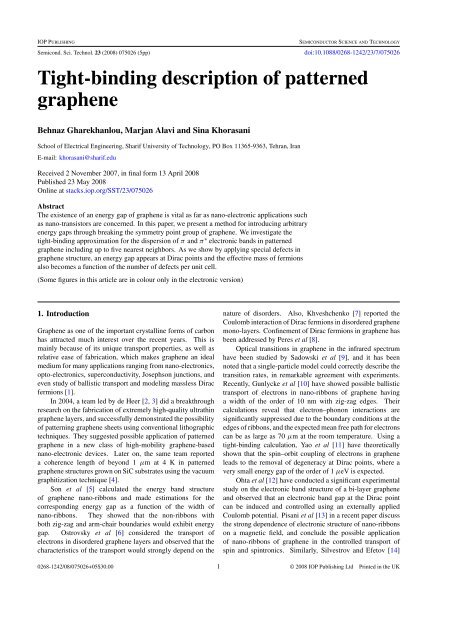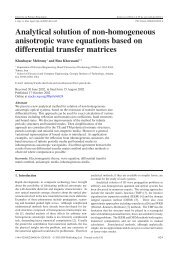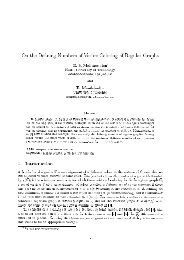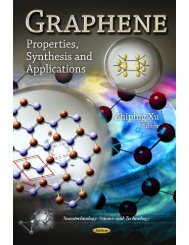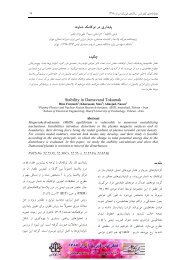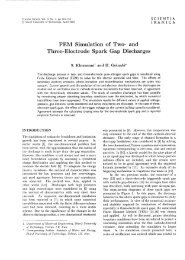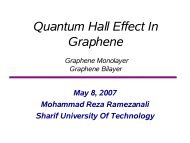Tight-binding description of patterned graphene
Tight-binding description of patterned graphene
Tight-binding description of patterned graphene
Create successful ePaper yourself
Turn your PDF publications into a flip-book with our unique Google optimized e-Paper software.
Semicond. Sci. Technol. 23 (2008) 075026B Gharekhanlou et alFigure 3. Showing a Dirac point in the band structure <strong>of</strong> <strong>graphene</strong> by taking first neighbors.Figure 4. Opening <strong>of</strong> an energy gap at Dirac points due to vacancies.structure <strong>of</strong> <strong>patterned</strong> <strong>graphene</strong>, E(κ)may be expanded aroundany <strong>of</strong> the Dirac points located at K asE c (κ) = + E c + ¯h2 [m∗ −12 c,x |κ x − K x | 2+ m ∗ c,y −1 |κ y − K y | 2] , (2a)E v (κ) = + E v + ¯h2 [m∗ −12 v,x |κ x − K x | 2+ m ∗ v,y −1 |κ y − K y | 2] , (2b)respectively, for conduction and valence bands. Here, E c,vcorresponds to the shifts in the peaks <strong>of</strong> conduction and valencebands due to patterning. Hence, the energy gap E g will besimply given byE g = E c + E v . (3)Please note the difference <strong>of</strong> (2a), (2b) to the bandstructure <strong>of</strong> un<strong>patterned</strong> <strong>graphene</strong> where the energy dispersionaround the Dirac points is given by the linear expressionE(κ) =±¯hV |κ − K|, with V being the 2D Fermi velocity[22].The energy band structure (2a), (2b) <strong>of</strong> <strong>graphene</strong> wouldeventually determine not only the effective mass <strong>of</strong> electronsand holes, but also the effective velocity <strong>of</strong> Fermionic Diracparticles which normally propagate in un<strong>patterned</strong> <strong>graphene</strong> ata speed <strong>of</strong> c/300, with c being the velocity <strong>of</strong> light in vacuum[1]. Also, as we later observe, there will be a noticeableanisotropy in the effective mass in the <strong>patterned</strong> <strong>graphene</strong>.In the tight-<strong>binding</strong> model applied here, it is assumed thatthe full Hamiltonian <strong>of</strong> the system may be approximated by theHamiltonian <strong>of</strong> an isolated atom centered at each lattice point,and only the effects <strong>of</strong> the first-nearest neighbors are involved.3
Semicond. Sci. Technol. 23 (2008) 075026B Gharekhanlou et alFigure 5. Typical patterning model <strong>of</strong> <strong>graphene</strong> with reduced symmetry (first- and second-nearest neighbors removed from the lattice).Hence, the atomic orbitals n (r), which are eigenfunctions<strong>of</strong> the single-atom Hamiltonian H at are assumed to be verysmall at distances exceeding the lattice constant. This is whatis normally meant by the tight-<strong>binding</strong> method. We furtherassume that any corrections to the atomic potential U(r),which are required to obtain the full Hamiltonian H <strong>of</strong> thesystem, are appreciable only when the atomic orbitals aresmall. The solution to the time-independent single-electronSchrödinger equation φ(r) is then assumed to be a linearcombination <strong>of</strong> atomic orbitalsφ(r) = ∑ b n n (r).n(4)This leads to a matrix equation for the coefficients b m andBloch energies ε(κ) <strong>of</strong> the formε(κ) = E m − β m + ∑ R≠0γ m (R) exp(iκ · R)b m + ∑ R≠0α m (R) exp(iκ · R) . (5)Here, E m is the energy <strong>of</strong> the mth atomic level, and∫β m =− m ∗ (r)U(r)φ(r) d3 r, (6a)α m (R) =∫m ∗ (r)φ(r − R) d3 r, (6b)∫γ m (R) =− m ∗ (r)U(r)φ(r − R) d3 r, (6c)are the corresponding transfer and overlap integrals.Before including the vacancy defects in <strong>graphene</strong>structure, we first calculate the band structure <strong>of</strong> <strong>graphene</strong>up to five nearest neighbors using the described tight-<strong>binding</strong>approach. Then we omit the terms related to the absentatoms from the summation <strong>of</strong> atomic potential terms in theHamiltonian. Here, as is normally done in the standard tight<strong>binding</strong>approximation, α m and β m are neglected in (5), andjust have applied the effect <strong>of</strong> the last overlap integral. Also,we note that in <strong>graphene</strong>, each <strong>of</strong> the two nearest atoms haveatomic orbital n (r) with opposite signs for the overall atomicorbitals as ±p z . The overlapping orbital obtained by theinterference <strong>of</strong> p z orbitals corresponds to the energy bandstructure ε(κ), and in particular π and π ∗ electronic bands asshowninfigure1.In figure 2, the arrangement <strong>of</strong> carbon atoms in <strong>graphene</strong>sheet is illustrated together its unit basis vectors, and the threenearest neighbors surrounding a central atom. As can be seenhere, there are three nearest, six second-nearest, three thirdnearestneighbors, etc. In figure 3 Dirac point is clearly seen(marked by the black circle) in the side view from the bandstructure <strong>of</strong> <strong>graphene</strong>. The calculations are done here by takingonly the first-nearest neighbors. As is evident from this figure,π and π ∗ electronic bands are almost completely conical acrossthe Dirac point. We also have calculated the band structure<strong>of</strong> <strong>graphene</strong> again this time with taking five nearest neighborsinto account. Since the computational cell size is artificiallyincreased, the band structure squeezes in the reciprocal space.Nevertheless, the symmetry and degeneracy at Dirac pointsare still preserved.In figure 4 the band structure <strong>of</strong> a <strong>patterned</strong> <strong>graphene</strong> isshown, with some atoms periodically taken out <strong>of</strong> the lattice.As can be easily seen, there is no further degeneracy at thepreviously Dirac points remains. In other words, an energygap is opened in justification <strong>of</strong> the diagram in figure 1. Asthe number <strong>of</strong> defects in a cell is increased, by taking thenext set <strong>of</strong> nearest neighbors, the corresponding energy gapvaries significantly as in table 1. Here, the energy gap reachesa maximum, when two <strong>of</strong> the second-nearest neighbors aredeleted. For instance, for the structure illustrated in figure 5,the symmetry point group is reduced from the original C 6 vpoint group to its C 3 v sub-group. The new super cellis marked with the dashed hexagon, which now includes1+3× 1+6× 1 2 +6× 1 = 9 atoms in each cell.3In contrast, Zhou et al [18] have recently obtained anenergy gap <strong>of</strong> 0.26 eV, a value close to that <strong>of</strong> our structure,by removing the translational symmetry. They have achievedthis symmetry breaking through lattice-mismatched expitaxialgrowth <strong>of</strong> <strong>graphene</strong> on SiC, which results in a strained<strong>graphene</strong> lattice. Finally, the dependence <strong>of</strong> the Fermioneffective mass on the number <strong>of</strong> defects is also tabulated intable 1 along the principal orthogonal directions. There is a4
Semicond. Sci. Technol. 23 (2008) 075026Table 1. Energy gap and fermion effective mass along the principaldirections versus the number <strong>of</strong> defects in the <strong>graphene</strong> structure.Number <strong>of</strong>Fermion effective massneighboring Gap Energyvacancies location gap (eV) m ∗ c/m 0 m ∗ v/m 00 K 0 – –1 ƔK 0.0081 0.02 0.02012 a M 4.1094 0.9312 1.51452 b ƔK 0.0103 0.0206 0.02073 c ƔK 0 0.0534 0.05314 d ƔK 0.01 0.0206 0.02075 e ƔK 0.01 0.0205 0.02066 f ƔK 0.0104 0.0212 0.0214a Two <strong>of</strong> the nearest neighbors removed.b One <strong>of</strong> the first and one <strong>of</strong> the second-nearest neighborsremoved.c All three nearest neighbors removed.d One <strong>of</strong> the first and three <strong>of</strong> the second-nearest neighborsremoved.e One <strong>of</strong> the first and four <strong>of</strong> the second-nearest neighborsremoved.f One <strong>of</strong> the first and five <strong>of</strong> the second-nearest neighborsremoved.remarkable anisotropy in the effective mass, mainly because<strong>of</strong> the newly reduced point group <strong>of</strong> the structure.3. ConclusionsWe have presented the electronic band structure <strong>of</strong> an orderly<strong>patterned</strong> <strong>graphene</strong> mono-layer, in the absence <strong>of</strong> externalelectric and magnetic fields, under the constraint that the<strong>graphene</strong> layer is <strong>patterned</strong> in such a way that carbon atoms areperiodically replaced by vacancies. This has been shown toeither leave the symmetry point group <strong>of</strong> the two-dimensionalhoneycomb structure either unchanged or reduced to the one<strong>of</strong> its sub-groups. We have demonstrated an adjustable energygap due to the removal <strong>of</strong> degeneracy at Dirac points, and adependence <strong>of</strong> Fermion effective mass as well as energy gapto the distance between vacancies.ReferencesB Gharekhanlou et al[1] Novoselov K S, Geim A K, Morozov S V, Jiang D,Katsnelson M I, Grigorieva I V, Dubonos S V andFirsov A A 2005 Nature 438 197[2] Berger C et al 2004 J. Phys. Chem. B 108 19912[3] Berger C et al 2006 Science 312 1191[4] Hass J, Feng R, Li T, Li X, Zong Z, de Heer W A, First P N,Conrad E H, Jeffrey C A and Berger C 2006 Appl. Phys.Lett. 89 143106[5] Son Y-W, Cohen M L and Louie S G 2006 Phys. Rev. Lett.97 216803[6] Ostrovsky P M, Gornyi I V and Mirlin A D 2006 Phys. Rev. B74 235443[7] Khveshchenko D V 2006 Phys. Rev. B 74 161402[8] Peres N M R, Castro Neto A H and Guinea F 2006 Phys. Rev. B73 241403[9] Sadowski M L, Martinez G, Potemski M, Berger C andde Heer W A 2006 Phys. Rev. Lett. 97 266405[10] Gunlycke D, Lawler H M and White C T 2007 Phys. Rev. B75 085418[11] Yao Y, Ye F, Qi X-L, Zhang S-C and Fang Z 2007 Phys. Rev. B75 041401[12] Ohta T, Bostwick A, Seyller T, Horn K and Rotenberg E 2006Science 313 951[13] Pisani L, Chan J A, Montanari B and Harrison N M 2007Phys. Rev. B 75 064418[14] Silvestrov P G and Efetov K B 2007 Phys. Rev. Lett.98 016802[15] Bunch J S, van der Zande A M, Verbridge S S, Frank I W,Tanenbaum D M, Parpia J M, Craighead H G andMcEuen P L 2007 Science 315 490[16] Bostwick A, Ohta T, Seyller T, Horn K and Rotenberg E 2007Nature Phys. 3 36 (Preprint cond-mat/0609660)[17] Novoselov K 2007 Nature Mater. 6 720[18] Zhou S Y, Gweon G-H, Fedorov A V, First P N, de Heer W A,Lee D-H, Guinea F, Castro Neto A H and Lanzara A 2007Nature Mater. 6 770[19] Tinkham M 1964 Group Theory and Quantum Mechanics(New York: McGraw-Hill)[20] Reich S, Maultzsch J, Thomsen C and Ordejón P 2002 Phys.Rev. B 66 035412[21] Pennington G and Goldsman N 2003 Phys. Rev. B 68 045426Pennington G and Goldsman N 2005 Phys. Rev. B 71 205318[22] Hwang E H and Das Sarma S 2007 Phys. Rev. B 75 205418(Preprint cond-mat/0610561)5


